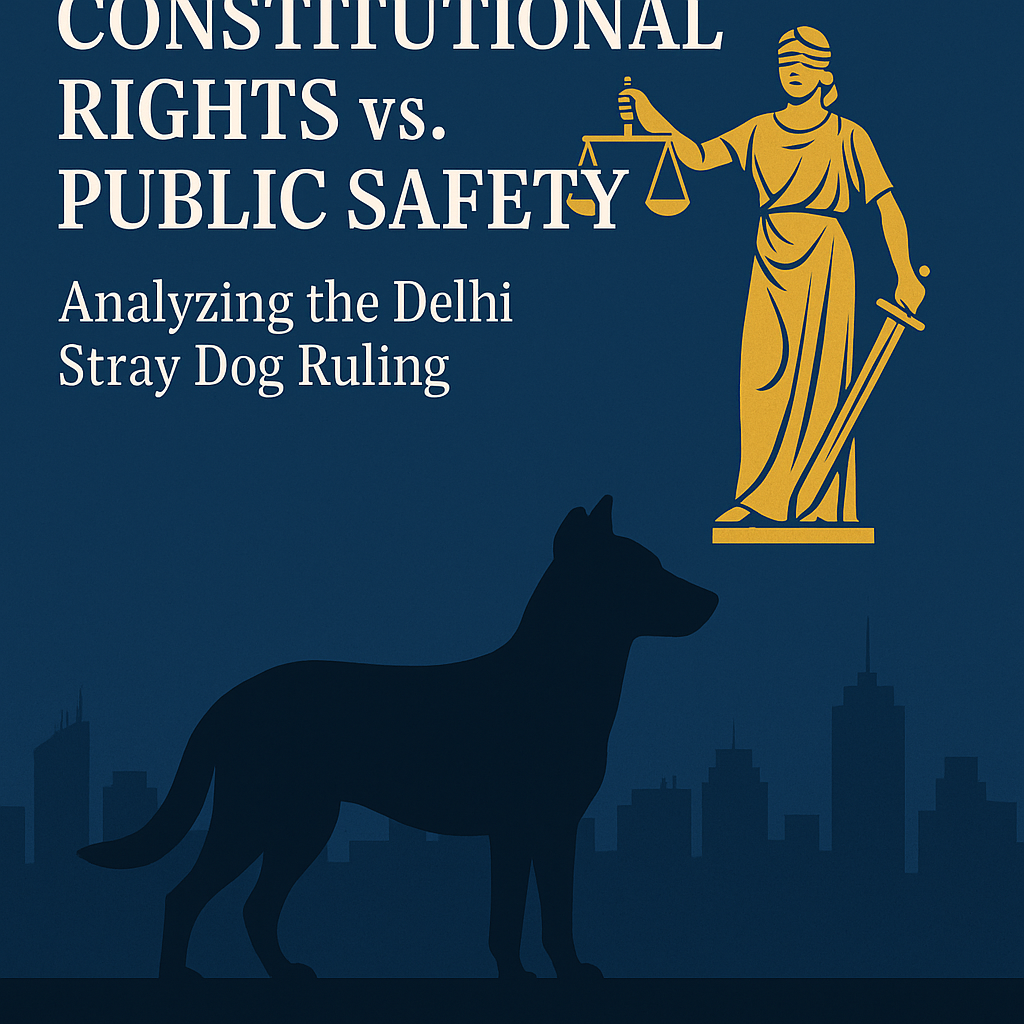Constitutional Rights vs. Public Safety: Analyzing the Supreme Court’s Delhi Stray Dog Ruling

On August 11, 2025, the Supreme Court of India issued a landmark directive ordering the removal of all stray dogs from Delhi-NCR within eight weeks, relocating them permanently to shelters and prohibiting their release back onto the streets.
This ruling — delivered in the context of rising dog bite incidents and rabies concerns — has sparked one of the most significant animal law debates in recent history, pitting public safety imperatives against constitutional protections for animals.
Constitutional & Statutory Framework
Fundamental Rights
- Article 21: Protects the right to life and personal safety for all citizens — a basis for addressing public health threats such as rabies.
- Article 51A(g): Imposes a fundamental duty on citizens to show compassion to all living creatures, forming the ethical foundation for animal welfare laws.
Key Legislation
- Prevention of Cruelty to Animals Act, 1960 (PCA Act) — the primary statute for animal protection in India.
- Animal Birth Control (Dogs) Rules, 2023 — mandates sterilization, vaccination, and return of stray dogs to their original locations, except in extreme health or aggression cases.
The conflict: The Supreme Court’s new order directly overrides the “sterilize–vaccinate–release” model set out in the ABC Rules, citing urgent public safety concerns.
Public Safety Concerns – The Trigger for Judicial Intervention
- Dog Bite Statistics: Over 35,000 incidents reported in Delhi in the first half of 2025 alone.
- Rabies Burden: India accounts for 36% of global rabies deaths, with most cases linked to dog bites.
- Urban Density Factor: Delhi’s crowded public spaces heighten the risk of stray dog–human conflicts.
The Court noted that the scale and speed of incidents warranted immediate action to protect the public.
Animal Rights & Welfare Perspective
Animal welfare advocates argue that:
- The ABC model has been endorsed by the WHO and previous Supreme Court rulings as the most humane and scientifically proven method to control stray populations.
- Removing dogs entirely can cause a “vacuum effect”, where unsterilized dogs from nearby areas move in, potentially increasing aggression and disease risk.
- Overcrowded shelters can lead to poor animal health conditions, contradicting the intent of the PCA Act.
The Judicial Balancing Act
The case represents a classic constitutional balancing problem:
- Public Safety (Article 21 – Right to life): Demands urgent mitigation of dog bite incidents.
- Animal Protection (Article 51A(g), PCA Act): Requires humane treatment and prevention of cruelty.
Historically, the Supreme Court has:
- In Animal Welfare Board of India v. A. Nagaraja (2014) — recognized animals’ right to live with dignity.
- In 2016 ABC-related cases — restricted indiscriminate culling of strays.
This August 2025 order marks a shift toward prioritizing human safety in the face of statistical urgency.
Implementation Challenges
- Shelter Capacity: Delhi lacks the infrastructure to accommodate over 1 million strays.
- Financial Strain: Estimates place costs above ₹15,000 crore for shelter creation, staffing, and maintenance.
- Operational Risk: Without concurrent sterilization and vaccination, relocation may simply displace the problem to other regions.
Possible Middle-Ground Solutions
- Targeted Removal: Focus on high-risk or aggressive dogs rather than blanket removal.
- Accelerated ABC Program: Scale sterilization and vaccination alongside temporary sheltering.
- Public Awareness Drives: Educate communities on safe coexistence and rabies prevention.
- Increased Funding: Both state and municipal budgets must be augmented for sustainable animal management.
Conclusion – The Need for Balanced Jurisprudence
The Delhi stray dog ruling is a watershed moment in Indian animal law, testing the limits of judicial intervention in policy matters.
While public safety is non-negotiable, animal welfare principles cannot be ignored without risking long-term ecological and ethical consequences.
A nuanced, science-based approach — integrating constitutional compassion with pragmatic safety measures — may be India’s best path forward.